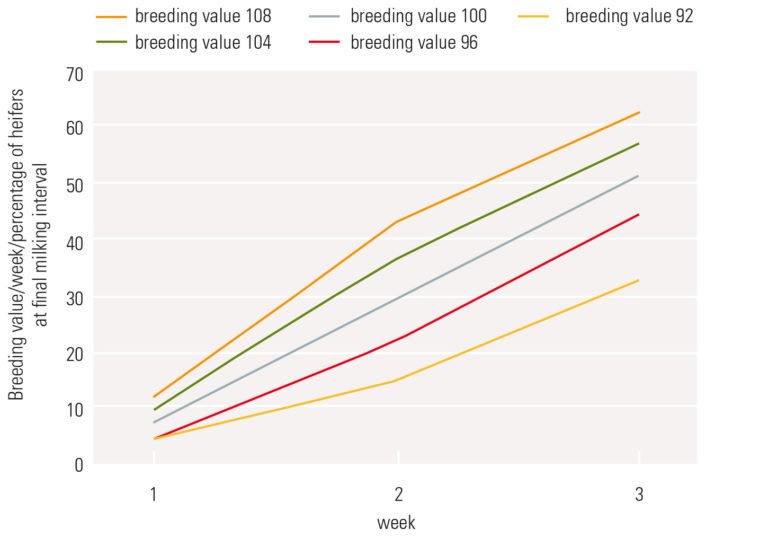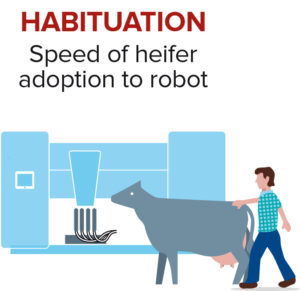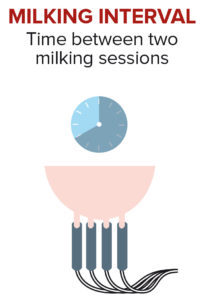How robot breeding values works
By using the robot traits, a dairy producer can aim for a herd which optimizes milking with an AMS. When added to selection criteria that includes production and confirmation, the CRV USA robot breeding values gives dairy producers more control over their breeding programs.
The table shows the result of breeding for just Robot Efficiency. The calculation presumes a farm with an average robot efficiency. The available robot time is 20 hours per day. In this example all other factors remained the same. Using sires with a breeding value of 108 for Robot Efficiency resulted in daughters producing 0.39 lb. more milk per minute. This yields 561 lb. more milk per robot per day and yearly almost 204,984 lb. extra milk per robot. With an average milk yield of 60 lb. milk per cow per day, a dairy farmer can milk up to nine extra cows per robot. However, it should be noted that selecting for Robot Efficiency alone can have negative effects on total volume of milk produced due to increased somatic cell count, as rapid milk out cows are more susceptible to mastitis.
| Breeding value | 92 | 96 | 100 | 104 | 108 |
|---|---|---|---|---|---|
| Phenotypical daughter average (lb. milk/min) | 3.16 | 3.36 | 3.56 | 3.76 | 3.96 |
| Extra lb. milk per minute | -0.39 | -0.19 | 0 | 0.19 | 0.39 |
| Extra lb. milk per robot per day | -561 | -273 | 0 | 273 | 561 |
| Extra lb. milk per robot per year | -204,984 | -99,645 | 0 | 99,645 | 204,984 |
| Extra cows per robot, at production of 60 lb. milk/day | -9.0 | -4.5 | 0 | 4.5 | 9.0 |

The Heifer Habituation breeding value can help producers train fresh heifers to quickly visit the robot by themselves. “This breeding value represents how quickly a heifer gets used to a robot. Dairy producers observe huge differences between heifers. For example, one heifer is used to the robot much more quickly than another and now CRV USA has a way of measuring that,” stated David Wilson, Breeding Program Manager at CRV USA. The offspring of sires with a high breeding value for Heifer Habituation more quickly reach the ideal milking frequency. Figure 1 shows the differences per breeding value.

The figure shows the correlation between the relative breeding value and the percentage of offspring reaching the ideal milking interval earlier. A breeding value above 100 represents that, on average, 50% of the offspring will reach the ideal milking interval by week 3 postpartum. Only 30% of the daughters from sires with a breeding value of 92 reach the final milking interval by week 3 postpartum.
CRV USA calculates the breeding value Heifer Habituation by comparing the milking interval between successful milkings in the period directly after calving (weeks 1, 2, and 3) to the milking interval in a period later in the lactation (weeks 10, 11, and 12). A smaller difference between the average visit interval from early lactation and the average interval of late lactation, means that heifers habituated to the system more rapidly. The Heifer Habituation breeding value is only available on daughter proven sires.

The breeding value for Milking Interval represents the time between two successful milking visits, or how frequently a cow visits the robot and is milked. The average score of cows is 507 minutes, or almost 8.5 hours, for milking visits. Using sires with a breeding value of 104 for Milking Interval results in daughters with a 16.5 minute shorter interval time. The variation in milking interval can be quite great. Cows can have milking intervals that are roughly between 350 and 650 minutes, depending on production, stage of lactation, and several other factors. Cows with a longer milk interval (cows who visit the robot less) have to be fetched more often, making more work for the producer.

Start now with robot breeding values!
Are you interested in robot breeding values or would you like some more information? Find a representative near you or request more information via our contact form.
